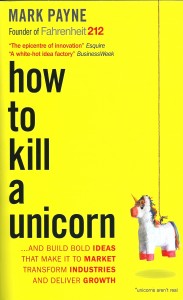The one-sentence summary
Innovation must build ideas at the crossroads of creativity and commerce, solving a big customer problem and a big business problem in one bold move.
WHAT THE BOOK SAYS 
- The failure rates of most innovations are absurdly high, culminating in ‘unicorns’ – visions that are lovely to think about, but only doable and profitable in some imaginary world.
- What is needed is a Money and Magic approach, sometimes called How and Wow. That’s where the ideas people and the commercial people work together from the off to solve both a customer and a business problem in one move.
- What goes in to an innovation process is always dozens of initiatives competing for resources. By the midpoint, nearly all solve a customer need. But they should only be implemented if they also solve a business need for the company.
- The moral is: don’t suspend commercial questions early in the process.
- This two-sided thinking (customer and company need) must start from day one. The best results come at the crossroads of the two requirements.
- Another crossroads comes at the intersection of near-term ROI, low risk tolerance, big growth goals, and tight resource constraints. Big doesn’t always mean risky, slow and expensive.
- The aim of marketplace disruption needs to be offset by the amount of company disruption in achieving it. A high effect on the market with low company upheaval is of course the Promised Land.
WHAT’S GOOD ABOUT IT
- Don’t buy into the myth that creativity is most effective when it’s unencumbered by practical imperatives.
- Transformational questions can be powerful in opening up bigger answers. You need to assume transformation is necessary, cultivate a healthy disrespect for present reality, and temporarily forget what you know.
- Learn to hear the thundering sound of the thing that isn’t being said.
- A company’s incompetencies can often provide the clue to how to innovate.
- “The details aren’t the details, they make the design.”
- In business-to-business markets, it is usually necessary to solve several different business models at once. Many initiatives fail because they concentrate just on the end user, failing to satisfy the demands of all the intermediaries and other companies involved in the process.
- Innovation needs tracking metrics: project success rates, in-market hit rates, and aggregate pipeline impact. Monitor all these, and you can prove that your innovations are indeed doing the right thing for the company.
WHAT YOU HAVE TO WATCH
- The author is founder of the innovation company Fahrenheit 212, and in large part this reads like a company brochure.
